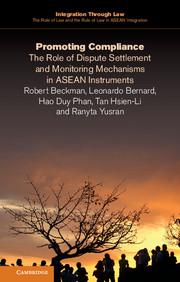Book contents
- Frontmatter
- Contents
- List of figures
- General editors’ preface
- List of abbreviations
- Introduction: overview and research rationale
- 1 The normative and theoretical underpinnings of ASEAN compliance behaviour
- 2 Dispute settlement mechanisms in ASEAN
- 3 Compliance monitoring mechanisms in ASEAN
- 4 Recommendations
- Executive summary
- Appendix 1 CIL’s observation on dispute settlement clauses in selected ASEAN agreements adopted prior to the ASEAN Charter
- Appendix 2 List of ASEAN instruments' provisions related to treaty compliance
- Bibliography
- Index
3 - Compliance monitoring mechanisms in ASEAN
Published online by Cambridge University Press: 05 March 2016
- Frontmatter
- Contents
- List of figures
- General editors’ preface
- List of abbreviations
- Introduction: overview and research rationale
- 1 The normative and theoretical underpinnings of ASEAN compliance behaviour
- 2 Dispute settlement mechanisms in ASEAN
- 3 Compliance monitoring mechanisms in ASEAN
- 4 Recommendations
- Executive summary
- Appendix 1 CIL’s observation on dispute settlement clauses in selected ASEAN agreements adopted prior to the ASEAN Charter
- Appendix 2 List of ASEAN instruments' provisions related to treaty compliance
- Bibliography
- Index
Summary
Unlike the Council of Europe or the EU, where efforts were made very early to develop strong compliance monitoring mechanisms in many respects of their cooperation, ASEAN's efforts to monitor member states’ implementation of regional commitments evolved very slowly, lacking the relative speed and comprehensiveness of ASEAN dispute settlement mechanisms. Without a secretariat or other forms of regional institutions in ASEAN's early years, none of the ASEAN instruments adopted between 1967 and 1976 prescribed institutional monitoring of the implementation of and compliance with ASEAN instruments. This task was left rather amorphously to whoever might be concerned or in charge. For instance, in 1972 and 1975 ASEAN adopted two agreements concerning the rescue of survivors of ship and aircraft accidents, but these agreements merely provided that their implementing bodies should be the ‘competent authorities’.
Fast forward to the post-ASEAN Charter situation today, the Secretary-General has de jure compliance monitoring powers but is, unfortunately, de facto emasculated. As the EPG Report emphasised, the real problem facing ASEAN, legally and institutionally, is compliance with and effective implementation of ASEAN instruments. ASEAN must establish a culture of honouring its promises and carrying them out on time in order to be taken seriously as a credible international actor. Regional compliance monitoring is heavily intertwined with how member states view ASEAN as an organisation and the types of institutional capacity with which it is invested.
The role of the ASEAN Secretariat in compliance monitoring
It is remarkable that ASEAN, as a regional organisation, even for the purposes of maintaining peaceful relations among member states existed for a decade without a centralised administrative body. In contrast, the Council of Europe, the Organization of the American States, and the Organization of African Unity – now replaced by the African Union – all have had their secretariats since their establishment in 1948, 1949 and 1963 respectively. In its first decade, ASEAN's administration was served by a standing committee and the national secretariats of the five original members. The lack of a centralised secretariat in the early years of ASEAN may not be unintentional. Pracha Guna-Kassem, a Thai diplomat who was present at the signing of the 1967 Bangkok Declaration, argued that if ASEAN had tried to establish a centralised secretariat in the beginning, it would have destroyed the nascent ASEAN by setting off a competition between its members over the location of the Secretariat.
- Type
- Chapter
- Information
- Promoting ComplianceThe Role of Dispute Settlement and Monitoring Mechanisms in ASEAN Instruments, pp. 101 - 159Publisher: Cambridge University PressPrint publication year: 2016

